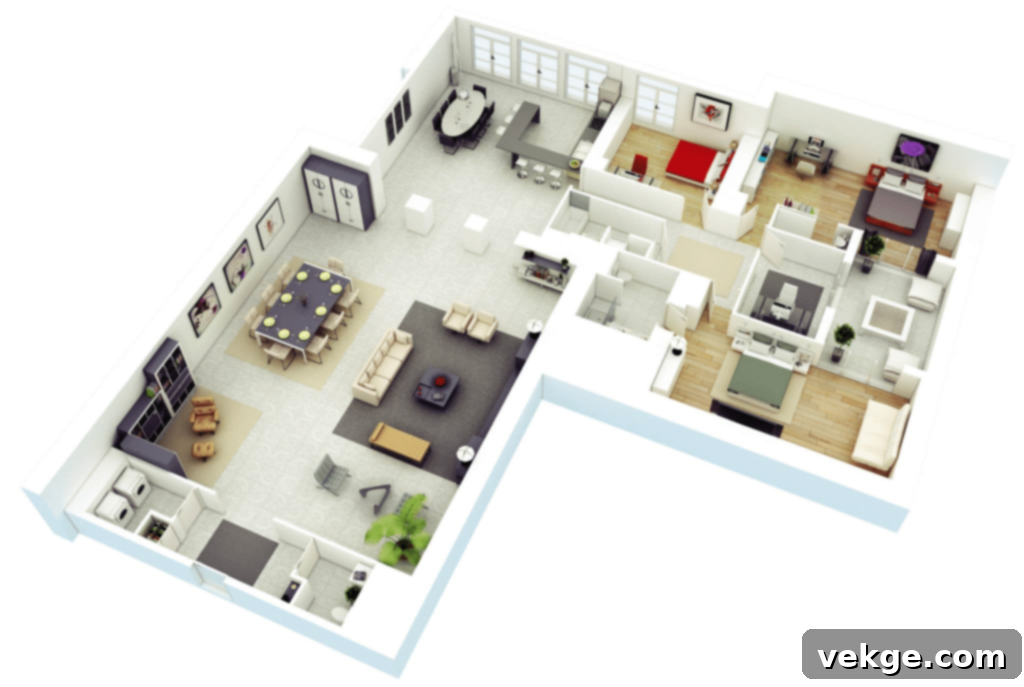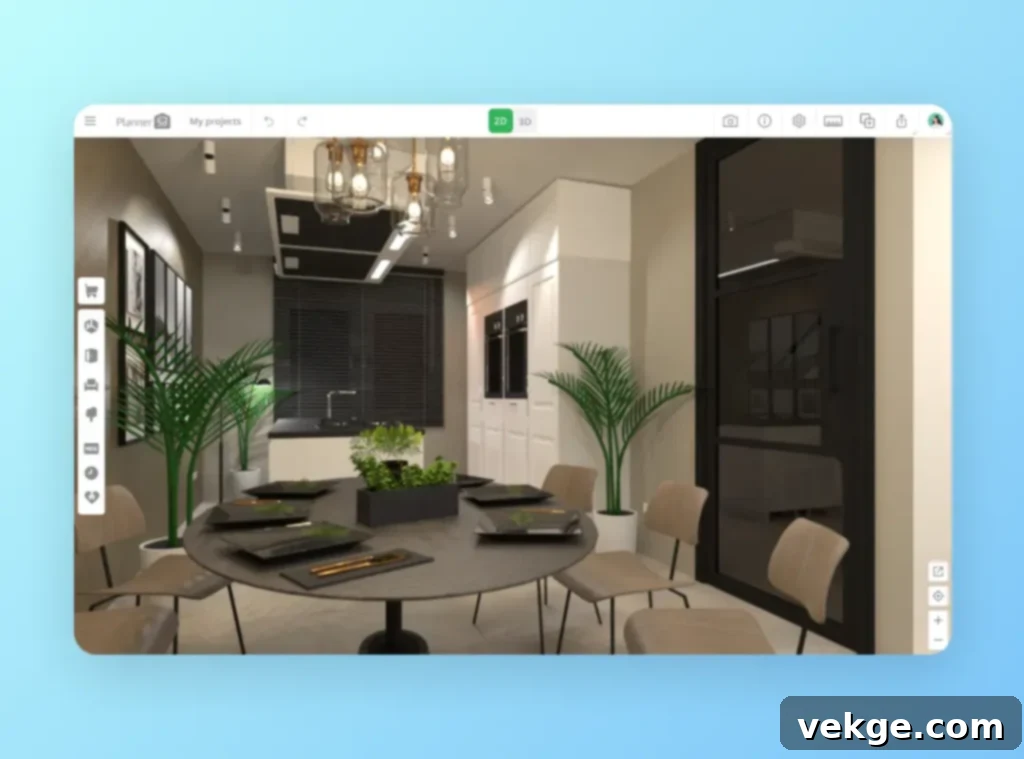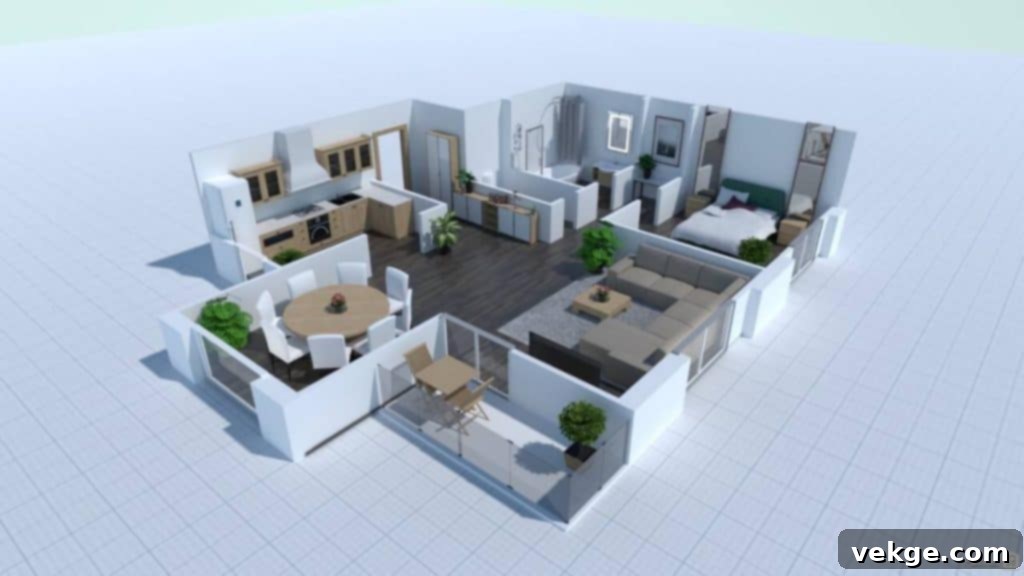Unlocking Your Creativity: A Beginner’s Guide to Mastering Interior Design Software
Embarking on the journey of interior design no longer requires years of specialized training or expensive professional tools. Thanks to the remarkable advancements in modern software, transforming your vision into reality is simpler and more accessible than ever before, even for the complete novice. With just a little bit of time and dedicated effort, anyone can start designing stunning interior spaces, bringing their creative ideas to life with unparalleled ease.
Modern interior design software serves as an indispensable ally for aspiring designers. Beyond merely aiding visualization, these powerful programs unleash a wealth of tools and features specifically designed to foster creativity, refine aesthetic sensibilities, and rapidly build essential design skillsets. This comprehensive guide will delve into the core aspects of contemporary interior design software, highlighting what beginners should prioritize, and offering a clear roadmap on how to confidently navigate popular tools and features, setting you on a path to design mastery.
Discovering the Core Capabilities of Interior Design Software
Before you dive into downloading any professional interior design software, it’s incredibly beneficial to first understand the fundamental capabilities that these applications offer. Grasping the potential of these tools will help you choose the right platform for your learning journey and design aspirations. Most programs, whether free or premium, equip users with a robust set of features, enabling them to:
- Create Detailed Floor Plan Layouts: Start by mapping out the dimensions of your room or entire home, adding walls, doors, and windows with precision.
- Experiment with Furniture Arrangements: Effortlessly drag and drop various furniture pieces, testing countless configurations to optimize flow and functionality.
- Edit Wall Colours and Textures: Virtually paint walls, apply different wallpapers, or experiment with various materials to find the perfect backdrop for your design.
- Incorporate Décor Elements and Accessories: Add finishing touches like rugs, curtains, artwork, and decorative items to personalize spaces.
- Place Light Fixtures: Explore different lighting scenarios, from ambient to task lighting, understanding how illumination impacts mood and perception.
- Visualize in 2D and 3D: Some software excels in precise 2D planning, ideal for foundational layout work, while others offer immersive 3D visualization, allowing you to walk through your design as if it were real.
For beginners, the key is to look for programs that offer a large and diverse furniture and materials catalogue, comprehensive built-in tutorials, and accessible video resources. User-friendly interfaces are paramount, allowing novices to start with simple tasks, satisfying initial curiosity and building confidence, while more advanced tools and features await their skill progression and growing ambition.
Starting Simple with Intuitive Room Planners
For those completely new to the world of digital design, basic 2D room planners provide an incredibly practical and non-intimidating introduction. These tools offer a straightforward approach to understanding spatial relationships without overwhelming users with complex visual rendering. With room planners, novices can easily input their room dimensions, then add fundamental structural elements such as walls, windows, doors, and different floor layers. The beauty of these planners lies in their simplicity, allowing you to focus on the core principles of space planning.

Once the basic structure is in place, you can effortlessly pull furniture, lighting fixtures, and accessories from a pre-designed catalogue into your layout, arranging them in different configurations. These simple programs intentionally focus on accurate floor plan creation rather than complex, photo-realistic visuals. This targeted focus allows beginners to truly grasp concepts of scale, proportion, traffic flow, and furniture placement. As a beginner learns the fundamentals of space planning, these planners help build crucial confidence and a solid understanding of design principles, ensuring a smooth and rewarding onboarding process into the world of digital interior design.
Cultivating Your Style: Engaging with Catalogue Exploration
When initially delving into interior design software, a fantastic and low-pressure starting point for beginners is to simply browse through the extensive furniture and décor catalogues. Forget about complex floor plans or intricate arrangements for a moment; just immerse yourself in the vast array of possibilities. Most programs boast thousands of furniture pieces spanning an impressive variety of styles, from modern sectionals and luxurious beds to functional dressers and ergonomic desks, and much more.
Beyond furniture, users can scroll through countless options for lighting, rugs, curtains, and an extensive collection of accessories. This initial catalogue exploration is more than just window shopping; it allows new users to comfortably soak in the immense possibilities at their fingertips without the immediate pressures of operating complex planning tools. It’s a critical step in developing your personal aesthetic.
During this phase, beginners begin to gain invaluable insight into the styles they naturally gravitate toward, whether it’s the clean lines of minimalist design, the cozy appeal of farmhouse chic, the timeless elegance of traditional decor, or the vibrant energy of bohemian spaces. You’ll also start to internalize key design vocabulary. From understanding the nuances between transitional and modern styles to distinguishing between coastal and contemporary aesthetics, these catalogues serve as indispensable precursors to actively designing and curating cohesive, beautiful spaces.
Accelerating Learning with Interactive Tutorials
One of the most valuable features integrated into many contemporary interior design software options is the inclusion of interactive tutorials. These intelligent guides are designed to walk users step-by-step through the onboarding process, introducing critical tools and functionalities in an engaging and digestible manner. Instead of sifting through dense, often overwhelming user manuals, these tutorials break down key features and complex processes into bite-sized, actionable walkthroughs.
Novices can systematically learn how to add specific furniture items, edit materials with different textures and finishes, incorporate diverse lighting concepts, place windows and doors, and even create custom elements. This guided learning approach significantly reduces the initial learning curve, making advanced software accessible to everyone.
These tutorials empower users with a sense of autonomy, allowing them to direct their own learning pace. You can repeat walkthroughs as many times as needed until you feel completely confident using a particular tool, and then confidently move forward independently. Furthermore, many platforms complement these interactive guides with supplementary video tutorials, expanding on more complex functions and offering visual demonstrations that cater to different learning styles. This multifaceted approach ensures that every beginner has the resources to master the software at their own pace.
Unleashing Creativity: Experimenting with Layouts and Materials
One of the most significant and liberating advantages of utilizing interior design software is the unparalleled freedom it offers for experimentation. This digital playground allows you to iterate countless layout ideas and sample an endless array of different finishes and materials without any real-world consequences or costs. Beginners should embrace this capability wholeheartedly, diving into playing around with various furniture arrangements and editing materials. This hands-on exploration is a powerful catalyst for driving inspiration and developing a deep understanding of how different items interact within a given space.
Unique and innovative layouts often emerge from simply shifting sofas, repositioning coffee tables, rotating rugs, or re-hanging art pieces. Each adjustment offers a fresh perspective, helping you visualize the optimal flow and aesthetic balance. Simultaneously, the ability to virtually sample a multitude of options—from rich wood stains and elegant granite colours to vibrant paint swatches and textured fabrics—opens up further possibilities for personalizing your design. As confidence gradually builds, novices can then expand their experiments to examine how subtle changes in lighting, the addition of decorative accessories, or even the choice of plants can profoundly impact the overall look, feel, and mood of a room. The key is to start simple, focusing on core elements, and then progressively expand the complexity of your experiments over time, continuously pushing the boundaries of your creativity.
Refining Vision: Incorporating Concept Boards
Most advanced interior design software programs provide a dedicated feature or integrate tools that enable users to curate dynamic inspiration and concept boards, also known as mood boards. These boards are invaluable for collecting and organizing visual ideas, typically featuring a collage of images, fabric patterns, furniture pictures, paint colour swatches, and any other elements that spark your imagination. For beginners, concept boards are an essential step in translating abstract inspiration into a tangible design direction.
You can effortlessly compile inspiration from a variety of sources – personal photos, intriguing websites, online catalogues, or even screenshots of real-world spaces – all with the goal of honing your own unique aesthetic. These images can be organized across digital tabs, virtual pinboards, or dedicated project areas within the software. The real power of concept boards lies in their ability to bridge inspiration with practical application: once curated, you can often incorporate elements, colours, or textures directly from your concept board into your 2D plans and 3D room designs. For instance, if a luxurious red chesterfield sofa on your mood board inspires a particular vision for a living room, the user can easily add a similar item from the software’s catalogue, then edit its colours and materials to match that inspiring image. Concept boards act as powerful catalysts, helping to concretize your inspiration and allowing novices to effectively manifest even their wildest design dreams into coherent, actionable plans.
Stepping into Realism: Visualizing Through 3D Rendering
Once you feel comfortable and proficient with 2D planning – having mastered floor plans and basic layouts – the natural next step for beginners is to level up their skills by transitioning to 3D visualization and rendering software. This move adds an incredible layer of realism and depth to your designs, allowing you to experience your creations from an entirely new perspective. Popular tools such as Autodesk Homestyler, Sweet Home 3D, or Space Designer 3D empower users to render interior spaces with stunning realism, providing the opportunity to explore designs from multiple vantage points, simulate light, and truly get a feel for the finished environment. 
After meticulously laying out floor plans in 2D, novices can then proceed to map realistic textures, apply accurate colours, and select specific materials onto surfaces within the 3D environment. This means that a virtual granite countertop will exhibit its distinct sheen, wooden flooring will display its natural grain and warmth, and painted drywall will accurately reflect chosen hues and finishes. When rendered in 3D, these elements incorporate realistic visual properties, allowing you to truly preview how your material choices will look and interact under different lighting conditions. This level of visualization is invaluable for making informed design decisions and ensuring your final design aligns perfectly with your aesthetic goals.
Leveraging Community Power: Connect with an Online Design Network
While built-in tutorials offer an excellent foundation, the learning journey in interior design software truly flourishes when connected with a vibrant online community. Beyond the confines of the software itself, many interior design platforms foster thriving community forums, social media groups, and dedicated online spaces where users actively share advice, proudly showcase their projects, and offer invaluable support to one another. Beginners should absolutely leverage this powerful peer-learning environment, which provides a constant source of inspiration, problem-solving assistance, and encouragement. It’s a place to glean fresh ideas, receive constructive feedback, and ask questions when encountering obstacles, knowing that experienced users are often eager to help.
Friendly subreddits, active Facebook groups, and dedicated user forums exist for most major interior design software options. These communities often feature discussions on best practices, troubleshooting tips, and even design challenges that can further hone your skills. Some platforms even enable direct collaboration on 3D projects, allowing you to learn from shared experiences. Connecting with fellow users not only alleviates potential frustration during the onboarding process but also reveals possibilities and creative approaches that no tutorial alone can convey. It makes the journey of mastering interior design software feel far less intimidating, transforming it into a collaborative and enjoyable experience.
In conclusion, while advanced tools empower seasoned professionals to elevate their designs to extraordinary levels, beginners need not feel overwhelmed or discouraged by the perceived learning curve. Modern interior design software has democratized the design process, making it incredibly accessible to anyone with a spark of creativity. With the abundant resources of supportive interactive tutorials, versatile experimentation tools, and thriving online community forums, interior design software offers expansive playgrounds for imaginative novices to confidently explore endless possibilities and progressively advance their skills over time. Start today, and watch your dream spaces take shape with unprecedented ease.
